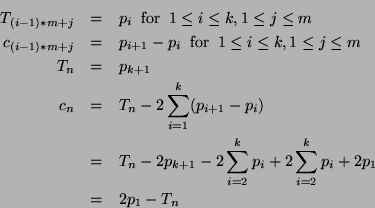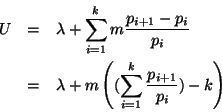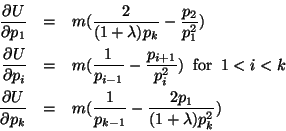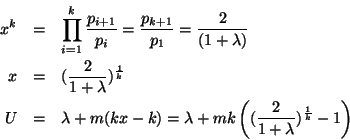The theorems and corollaries above are intended for use as
schedulability tests. They can be applied directly to prove that
a task set will meet deadlines with DM or RM scheduling, either
before run time for a fixed set of tasks or during run time as an
admission test for a system with a dynamic set of tasks. With the
simpler forms, one computes ![]() and then checks the
schedulability condition once for the entire task set. With the
more general forms, one checks the schedulability condition for
each task. In the latter case the specific value(s) of
and then checks the
schedulability condition once for the entire task set. With the
more general forms, one checks the schedulability condition for
each task. In the latter case the specific value(s) of ![]() for
which the test fails provide some indication of where the problem
lies.
for
which the test fails provide some indication of where the problem
lies.
The schedulability tests of Theorems 12 and
18 allow preperiod deadlines, but are more complicated
than the corresponding utilization bound tests. It is natural to
wonder whether this extra complexity gains anything over the well
known technique of ``padding'' execution times and then using the
utilization bound test. By padding the execution times we mean
that if a task ![]() has execution time
has execution time ![]() and deadline
and deadline
![]() , we replace it by
, we replace it by ![]() , where
, where
![]() and
and ![]() .
.
With deadline monotonic scheduling, the original task ![]() can be scheduled to meet its deadline if the following condition
holds for
can be scheduled to meet its deadline if the following condition
holds for ![]() :
:

There are cases where this test is less accurate than that of
Theorem 18. Suppose we have three processors and three
tasks, with periods ![]() , deadlines
, deadlines ![]() ,
,
![]() , and compute times
, and compute times
![]() . Obviously, the
tasks are schedulable. However, if we apply the padded
utilization test to
. Obviously, the
tasks are schedulable. However, if we apply the padded
utilization test to ![]() , we have
, we have
![]() , and
, and
![]() . The test fails, as follows:
. The test fails, as follows:


A similar padding technique can be applied for EDF, but again it is sometimes less accurate than Theorem 12.
Of course, these schedulability tests are only sufficient
conditions for schedulability. They are like the Liu and Layland
![]() utilization bound, both in being very
conservative and in still having practical value.
utilization bound, both in being very
conservative and in still having practical value.
Though the utilization tests are not tight in the sense of being
necessary conditions for schedulability, Goossens, Funk, and
Baruah[8] showed that the EDF bound is tight in the
sense that there is no utilization bound
![]() , where
, where ![]() and
and
![]() , for which
, for which
![]() guarantees EDF schedulability. Since the EDF
utilization bound is tight it is natural to wonder whether the
same is true of the RM bound. The following threorem shows that
it is not tight.
guarantees EDF schedulability. Since the EDF
utilization bound is tight it is natural to wonder whether the
same is true of the RM bound. The following threorem shows that
it is not tight.
Proof:
The task set and analysis are derived from Liu and Layland[13].
The difference is that here there are ![]() processors instead of one, and the utilization of the
longest-period task is bounded by a
processors instead of one, and the utilization of the
longest-period task is bounded by a ![]() .
.
The task set contains ![]() tasks where
tasks where ![]() is an arbitrary
integer greater than or equal to 1. The task
execution times and periods are defined
in terms of a set of parameters
is an arbitrary
integer greater than or equal to 1. The task
execution times and periods are defined
in terms of a set of parameters
![]() as follows:
as follows:

These constraints guarantee that task ![]() barely has time to
complete if all
barely has time to
complete if all ![]() tasks are released together at time zero. The
RM schedule will have all
tasks are released together at time zero. The
RM schedule will have all ![]() processors busy executing tasks
processors busy executing tasks
![]() for
for
![]() out of the
out of the ![]() available time units,
leaving exactly
available time units,
leaving exactly ![]() units to complete
units to complete ![]() .
.
If
![]() , we have
, we have

We will choose
![]() to minimize the total utilization, which is
to minimize the total utilization, which is

The partial derivatives of ![]() with respect to
with respect to ![]() are
are

Since the second partial derivatives are all positive, a unique global minimum exists when all the first partial derivatives are zero. Solving the equations above for zero, we get

Let
![]() . It follows that
. It follows that

L'Hôpital's Rule can be applied to find the limit of the above expression
for large ![]() , which is
, which is
![]() .
.
![]()
We conjecture that the upper bound on the minimum achievable RM utilization achieved by the example above may be tight.
Srinivasan and Baruah[18] and Andersson, Baruah, and
Jonsson[2] showed how to relax the restriction that
![]() in the utilization tests, for situations
where there are a few high-utilization tasks. They
propose EDF and RM versions of a hybrid scheduling policy called
EDF/US[
in the utilization tests, for situations
where there are a few high-utilization tasks. They
propose EDF and RM versions of a hybrid scheduling policy called
EDF/US[![]() ], where
], where
![]() for EDF
and
for EDF
and
![]() for RM.
for RM.
EDF/RM-US[![]() ]:
]:
(heavy task rule)
If
![]() then schedule
then schedule ![]() 's
jobs at maximum priority.
's
jobs at maximum priority.
(light task rule)
If
![]() then schedule
then schedule ![]() 's
jobs according to their normal EDF or RM priorities.
's
jobs according to their normal EDF or RM priorities.
They then proved two theorems, which we paraphrase and combine as follows:
The proof is based on the observation that the upper bound on
total utilization guarantees that the number of heavy tasks cannot
exceed ![]() . The essence of the argument is that the algorithm
can do no worse than scheduling each of the heavy
tasks on its own processor, and then scheduling the remainder (which
must must be light on the remaining processors) using the regular
EDF or RM algorithm.
. The essence of the argument is that the algorithm
can do no worse than scheduling each of the heavy
tasks on its own processor, and then scheduling the remainder (which
must must be light on the remaining processors) using the regular
EDF or RM algorithm.
The above result can be generalized slightly, as follows:
Proof:
As argued by Srinivasan and Baruah, the
performance of this algorithm cannot be worse than an algorithm that
dedicates one processor to each of the heavy tasks, and uses EDF or RM to
schedule the remaining tasks on the remaining processors.
The utilization bound theorem then guarantees the remaining tasks
can be scheduled on the remaining processors.
![]()
If there is a need to support preperiod deadlines, this idea can be taken further, by changing the ``heavy task rule'' to single out for special treatment a few tasks that fail the test conditions of one of our schedulability tests that allows preperiod deadlines, and run the rest of the tasks using EDF or DM scheduling.